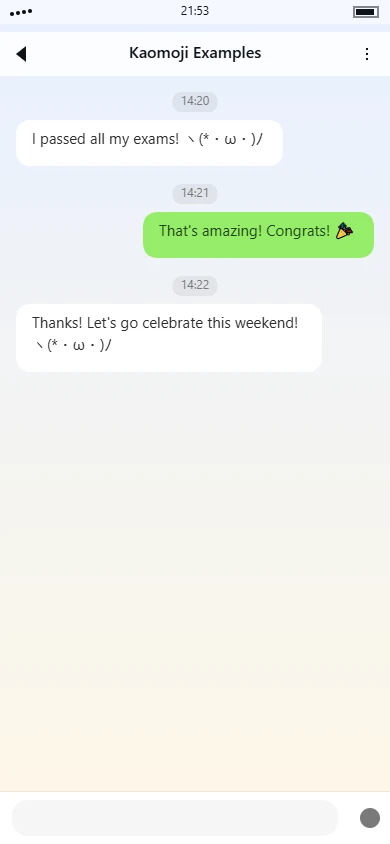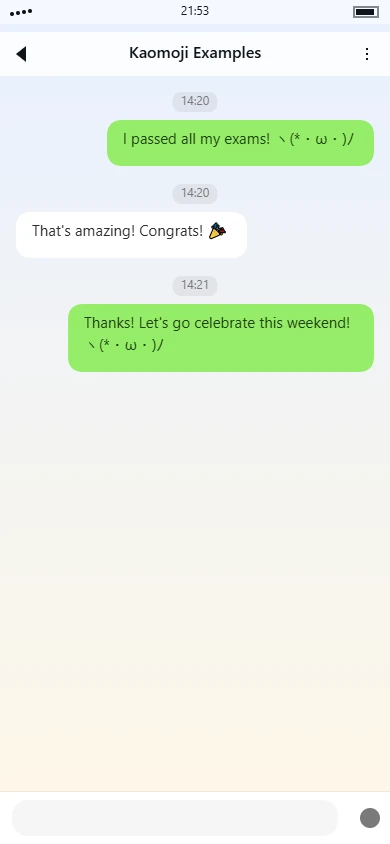(o˘◡˘o) kaomoji meaning | usage tips

Overview
The kaomoji
(o˘◡˘o)()o˘◡˘˘◡Symbol Breakdown
- Parentheses
and(
: These curved brackets define the facial outline, suggesting a full, rounded face shape that contributes to a soft visual appearance) - Letter
as eyes: The symmetrical placement of lowercase o characters creates simple circular eyes that maintain the rounded theme of the designo - Combining breve
: These diacritical marks flank the mouth element, extending the curved lines outward from the central mouth shape˘ - Greek capital letter omega
: This character forms the main upward curve of the mouth, creating a smiling expression through its arch-like shape◡ - Overall symmetry: The balanced arrangement of elements on both sides of the vertical axis creates visual harmony and stability
Emotion & Aesthetic Analysis
The kaomoji conveys a contented, gentle happiness through its upward-curving mouth and rounded forms. The expression falls somewhere between a subtle smile and a more pronounced grin, suggesting satisfaction rather than exuberant joy. The rounded cheeks created by the parentheses give the face a slightly chubby appearance, which can be associated with innocence or contentment.
Compared to similar smiling kaomoji, this version has a more contained emotional range. It lacks the exaggerated elements of more energetic expressions like
(^▽^):)In practical use, this kaomoji typically appears in contexts where the writer wants to express mild pleasure, agreement, or gentle amusement. It works well for acknowledging messages positively without being overly enthusiastic, and its constructed nature makes it suitable for situations where a more deliberate or stylized expression is preferred over simpler alternatives.
Tag categories
Use tags to quickly understand this kaomoji.
Usage guide
Usage Guide for (o˘◡˘o)
The kaomoji (o˘◡˘o) is a charming and versatile expression that captures a sense of gentle contentment and innocent happiness. This particular arrangement of characters creates a face with rounded cheeks and a subtle smiling mouth, conveying a warm, satisfied emotion that's neither overly excited nor completely neutral. It's perfect for those moments when you want to express quiet pleasure, mild satisfaction, or a gentle sense of accomplishment without coming across as boastful or exaggerated. You'll often see this kaomoji used in casual online conversations, gaming chats, social media comments, and friendly messaging where the tone is lighthearted and the relationship between communicators is comfortable and informal.
What makes (o˘◡˘o) particularly effective is its ability to soften messages that might otherwise sound blunt or matter-of-fact. The rounded 'o' characters on either side create a sense of fullness and completeness, while the central smiling element suggests a genuine but understated positive emotion. This kaomoji works well across various digital platforms including Discord servers, Twitter replies, Instagram comments, and casual workplace messaging apps like Slack when used among colleagues who share a friendly rapport. It's especially popular in communities that appreciate cute or kawaii aesthetics, as the rounded features and gentle expression align well with that visual style.
Common Use Cases
- Expressing quiet satisfaction after completing a small task or project
- Responding to a friend's good news with gentle enthusiasm
- Adding warmth to a simple "thank you" in casual conversations
- Showing appreciation for a cute photo or heartwarming story shared online
- Softening a request to make it sound more polite and less demanding
- Reacting to comforting news or reassuring information from friends
- Celebrating small victories in gaming or personal achievements
- Responding to compliments with humble acceptance rather than bold confidence
- Expressing contentment while sharing simple pleasures like enjoying a good meal
- Adding personality to routine check-ins with close friends or family
- Conveying gentle encouragement to someone who's feeling uncertain
- Wrapping up a positive conversation on a warm, satisfied note
Example Conversations
-
Friend sharing good news Person A: "I finally finished organizing my entire book collection!" Person B: "That's awesome! Bet it feels great to have it all sorted (o˘◡˘o)"
-
Casual thank you exchange Person A: "Thanks for picking up coffee on your way over" Person B: "Of course! Happy to help (o˘◡˘o)"
-
Gaming achievement Player A: "Just reached level 50 without any power-ups" Player B: "Nice! Clean playthrough (o˘◡˘o)"
-
Comforting reassurance Person A: "I was worried about that presentation but it went okay" Person B: "See? You had nothing to worry about (o˘◡˘o)"
-
Sharing simple pleasures Person A: "This new tea is surprisingly good" Person B: "Right? Perfect for rainy days (o˘◡˘o)"
-
Workplace casual chat Colleague A: "The meeting got moved to 3 PM instead of 2" Colleague B: "Thanks for the update (o˘◡˘o) gives me time to finish this report"
Important Notes
-
Avoid using this kaomoji in formal emails, professional correspondence, or serious discussions where a more straightforward tone is expected. The cute, informal nature might undermine your professional credibility in these contexts.
-
Be mindful that this expression conveys gentle satisfaction rather than strong excitement. If you need to express more enthusiastic emotions, consider using kaomoji with wider eyes or more pronounced smile elements.
-
In some cultural contexts, particularly in very direct communication styles, this kaomoji might be perceived as somewhat passive or indecisive. Adjust your usage based on your relationship with the recipient and their communication preferences.
This kaomoji works particularly well when you want to maintain a positive tone without appearing overly enthusiastic or intense. It's the digital equivalent of a gentle, knowing smile that says "I'm content with how things are going" rather than "I'm ecstatic!" The balanced nature of the expression makes it suitable for a wide range of mildly positive situations while keeping the conversation light and approachable.
When used appropriately, (o˘◡˘o) can enhance your digital communication by adding a layer of warmth and personality that plain text often lacks. It's especially valuable in text-based communication where facial expressions and tone of voice are absent, serving as a subtle emotional cue that helps prevent misunderstandings and maintains positive rapport with your conversation partners across various online platforms and messaging applications.
Usage examples
Real conversation samples that feature this kaomoji.

Example 1

Example 2
Related kaomoji
You might also enjoy these kaomoji.